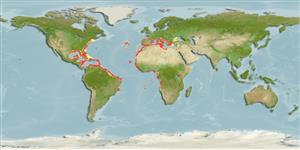Common names from other countries
Classification / Names / Names
Namen | Synonyme | Catalog of Fishes (gen., sp.) | ITIS | CoL | WoRMS
Environment: milieu / climate zone / depth range / distribution range
Ökologie
Benthopelagisch; tiefenbereich 20 - 828 m (Ref. 8), usually 100 - 400 m (Ref. 8). Subtropical; 8°C - 15°C (Ref. 804), preferred 24°C (Ref. 107945); 48°N - 19°S, 98°W - 37°E
Atlantic and the Mediterranean: from USA to French Guiana, the entire Mediterranean and from Portugal to Namibia.
Length at first maturity / Size / Gewicht / Alter
Maturity: Lm 2.4, range 1 - 2.8 cm Max length : 16.0 cm TL Männchen/unbestimmt; (Ref. 8); 19 cm TL (female); common length : 14.0 cm TL Männchen/unbestimmt; (Ref. 8); common length :16 cm TL (female); max. veröff. Alter: 3.00 Jahre (Ref. 80253)
Demersal (Ref. 85316). Maximum depth range from Ref. 114857; minimum common depth from Ref. 80253. Maximum total length (female) from Ref. 104052 Prefers mud or muddy sand substrates (Ref. 8). Juveniles settle at around 100 m, though can be detected up to 300 m, while larger individuals are always found deeper than 350 m (Ref. 80253). Feeds on benthic organisms (clams, mysids and small crangonids; Ref. 434). Also occurs in pelagic depths between 100 to 200 m (Ref. 92299). Opportunistic predator (Ref. 112170).
The species has a life cycle of 2 to 3 years (Ref. 80253). Mating behavior: Precopulatory courtship ritual is common (through olfactory and tactile cues); usually indirect sperm transfer (Ref. 833).
Holthuis, L.B. 1980. (Ref. 8)
IUCN Rote Liste Status (Ref. 130435)
CITES Status (Ref. 108899)
Not Evaluated
Not Evaluated
Nutzung durch Menschen
Fischereien: kommerziell
FAO - Fischereien: landings, Artbeschreibung | FIRMS (Stock assessments) | FishSource | Sea Around Us
Tools
Internet Quellen
Estimates based on models
Preferred temperature
(Ref.
115969): 9.4 - 19.5, mean 14 (based on 393 cells).
Widerstandsfähigkeit
hoch, Verdopplung der Population dauert weniger als 15 Monate. (K=0.44-2; tm=0.6; tmax=3).
Prior r = 1.40, 95% CL = 0.92 - 2.10, Based on 15 full stock assessments.
Verwundbarkeit
Low vulnerability (10 of 100).
